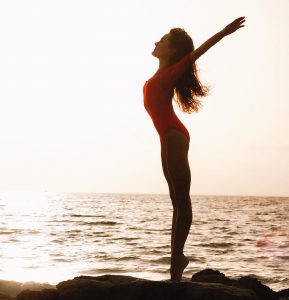
Ishvara Pranidhana is the fifth Niyama. The Niyamas, the five social observances, are the second of the eight limbs of yoga. Ishvara Pranidhana translates as “surrender to god” but it can also be interpreted as surrendering to our higher power, to the Divine timing of the Universe or simply surrendering to the natural flow of life and events. A phrase we are all familiar with, “going with the flow” speaks to this Niyama.
Surrender
What does it mean to surrender? Some people view surrender as giving in or giving up. Others might interpret it as “let go and let god”. Still others might see it as compromising our dreams or desires. In terms of yoga, surrender means to release resistance and there are several ways we work with resistance in our practice.
As with all things in yoga (and in much of life) we begin with the physical. Yoga is often described as a balance of opposites and we work with these opposing forces in the body – rooting to rise, drawing in to lengthen, and holding the outer form of the pose firmly while at the same time softening on the inside. Once we become practiced at finding what Buddha would call “the middle way” and embodying it in our yoga postures, we balance in the space between and turn our awareness to the breath. It is at this point in the practice that we can start to identify the places where resistance manifests in the body and consciously work to release them with the breath.
After a time, with consistent practice, we become more skilled at striking this balance in our asana practice and the embodiment of that wisdom leads us to examine where we put up resistance in other areas of our lives. This is where our practice of Ishvara Pranidhana truly begins.
Identifying Resistance
Let’s begin with the mind. Over the course of our lives, we develop notions and ideas that form the framework of our belief system which then influences our relationship with the world and everyone and everything in it. The mind is often the first place we experience resistance as we hear/see/read/witness something that is counter to our beliefs. The mind then says, “That’s not right!”, and we react in kind, immediately pushing back against that information. There is another saying, “What we resist, persists.” How often have we found ourselves in a situation where we try over and over to reason with someone who doesn’t see things our way? At what point do we let go of being right? Are we able to accept that it’s best to agree to disagree, or if that’s not possible, are we able to drop the matter all together?
One way we resist is in the pacing of our lives. A small but frequently-occurring example is in the unfolding of the day or a project we might be working on. Have you ever had one of those days where nothing goes right? Maybe we oversleep the alarm on a busy day and immediately we feel the pressure to make up that lost time. Our energy is frustrated and contracted, we are irritated and unwittingly call more challenge to ourselves. (This is based on the Law of Attraction – the belief that positive or negative thoughts bring positive or negative experiences into our lives.) It persists throughout the day unless we find a way to shift our energy by adapting to the change in plans. I am only half-joking when I say to my yoga students “yoga makes us flexible – and I’m not just talking about your body”.
Another way resistance may present itself is in the unfolding of a project. Only in rare instances do our plans for our projects go exactly as planned. More often, there are delays and interruptions, mistakes and forgotten details. Can we accept that this is the pace at which this particular event is supposed to move? Or, if we encounter too many roadblocks, maybe it is an indication that we are not meant to see it out. Are we able to accept the signs and choose a different course of action? How many times in our lives have we forced the pace in anticipation of reaching an outcome, only to have it not turn out the way we had hoped? In the end, we are forced to take a different path anyway. If we can have the presence of mind to accept the indications that we should change course, it makes the journey go much more smoothly, and more often than not, we arrive in a place of greater fulfillment and certainly do so with greater ease.
The biggest life event to present resistance is change. Change of any kind. Our response to change ranges across a spectrum from total acceptance to total resistance and everything in between. Some people easily adapt to changes in circumstance, while others are thrown into a downward spiral of resistance resulting in anything from anger and resentment to fear and anxiety. This is where the practice of Ishvara Pranidhana serves us, as change is truly the only constant of life. Over time with this practice, we learn to accept the roadblocks as signs we are meant to take a different path – perhaps the same destination, just a different route – or maybe we are intended to reach an entirely different destination altogether. It matters not if the path to our next destination is circuitous or straight, as long as we experience forward movement. It may take longer than we anticipate, and if so, are we able to trust in the Divine pacing moving us forward and step into the flow of Grace?
Learning to Flow
Hopefully, we have all had the experience of being “in the zone” or “in the flow”. Many books have been written on this topic. Athletes often describe being in the zone – where everything moves without restriction, every movement is conducted with confidence and grace, knowing they will hit the mark every time. Non-athletes are familiar with this phenomenon as well, the days when all goes smoothly, when we nail the presentation and like Midas, everything turns to gold at our fingertips. What makes these days different from the challenging ones? If we look closely, we see that it is our energy that is the difference. The events are the same – it is our response to them that is different. We don’t think about being in the flow when all is going right – that’s why the practice of mindfulness is enjoyable when we find ourselves in the valleys of life, and it is essential when we are climbing the mountain. It is this awareness that leads us to be able to engage our surrender wisely so we can “go with the flow” as often as possible.
I prefer to use the word flow as it depicts the flow of water, which in its quiet wisdom, always chooses the path of least resistance. Lately, I have made a practice of deliberately choosing the path of least resistance. Even, and especially, when I’m tempted to do otherwise. I find it is really a practice in detachment (Aparigraha, non-clinging, the fifth Yama). Often what drives our resistance is that, consciously or subconsciously, we are attached to an idea or outcome. When we see that things aren’t going our way or not turning out how we had anticipated, we resist what is actually occurring. The practice of detachment is continual and ongoing – first it is a noticing of what we are attached to, followed by a practice of what we do with that notice. Are we willing to change or let go of our attachments as we become aware of them? Can we objectively consider how our desire for a particular outcome is impacting our lives? Couple these considerations with our yoga practice of embodying the letting go and they become a life practice of self-awareness and self-realization.
Over time, we begin to understand that we actually have control over very little in our lives – only ourselves and that which is in our direct control. We cannot control other people, their choices or behavior, and we definitely cannot control outcomes. We can influence them, but we cannot manage them. Part of surrender is asking ourselves if we have done all we can do to influence a certain situation and if the answer is yes, then there is nothing left to “do”. We must simply witness what unfolds and manage our response (preferably a response and not a reaction) to the outcome. If the answer is no, then we should strive to perform actions within our direct control – doing so mindfully, kindly and compassionately. Once this is complete, just like in our asana practice, there is nothing more to do but breathe. As I like to say, “now you’re in the pose, all you do is breathe.”
Grace
Through the practice of yoga we reach a point of willing surrender. As we surrender into the flow and allow Divine pacing to unfold, we become fluid, taking the path of least resistance, flowing with Grace and embodying that Grace in physical form.
Grace cannot be touched or held, it must be witnessed and experienced. It is ethereal, formless, beautiful beyond expression – timeless and silent, peaceful and serene. When we are embodying the wisdom of surrender, detachment and allowing, this is the frequency in which we journey through life. We find ourselves less rigid, more open and able to adapt to change as it manifests in our lives. We are indeed flowing with Grace.
Just as water flows effortlessly at times, and at other times encounters obstacles it must go over or around, we, too, have times where everything flows smoothly and other times where we experience challenge and stagnation. In keeping with our water analogy, it is important to remember that water possesses the power to change the surfaces it flows over – creating the smooth texture of river rocks and shaping the earth with its currents. In the same way, we possess the ability to influence and change our circumstances if we choose the way of the water – the path of least resistance.
Practice
I encourage you in these ever-changing times (but truly, when have times ever not been changing?) to explore the practice of deliberately choosing the path of least resistance. If you are encountering resistance (or creating that resistance for yourself) choose a different route or means of communication. In your yoga practice, try doing modified versions of poses even if you can do the full pose. Try to enjoy being in a version of the pose that’s easily sustained so you can focus and be present with the breath. When we allow ourselves to soften into that place of willing surrender we feel the flow, the flow of Prana (life energy) and move with the Grace of the Universe – freely, effortlessly and joyfully. This is Ishvara Pranidhana.
In Light,
Michelle
